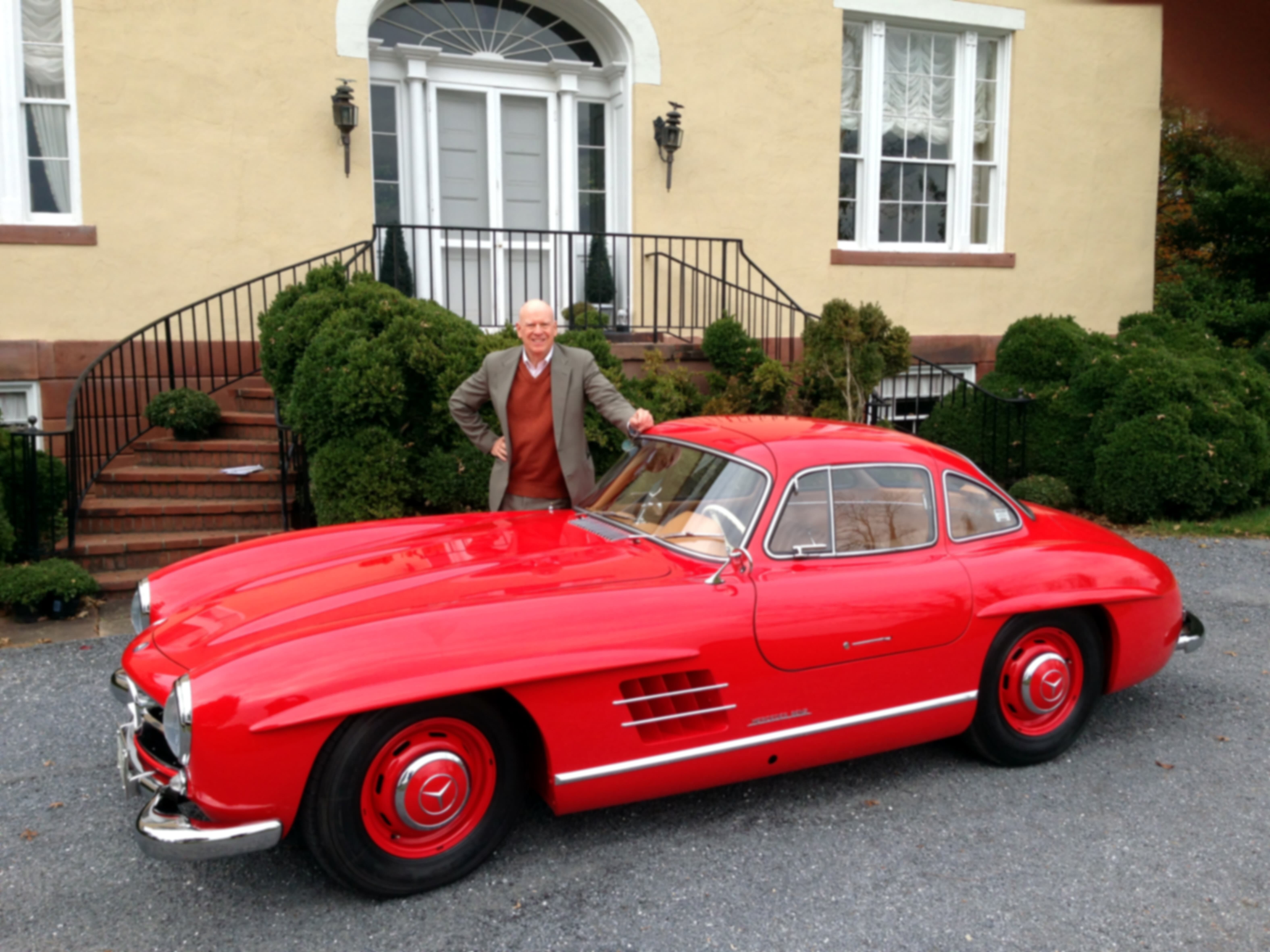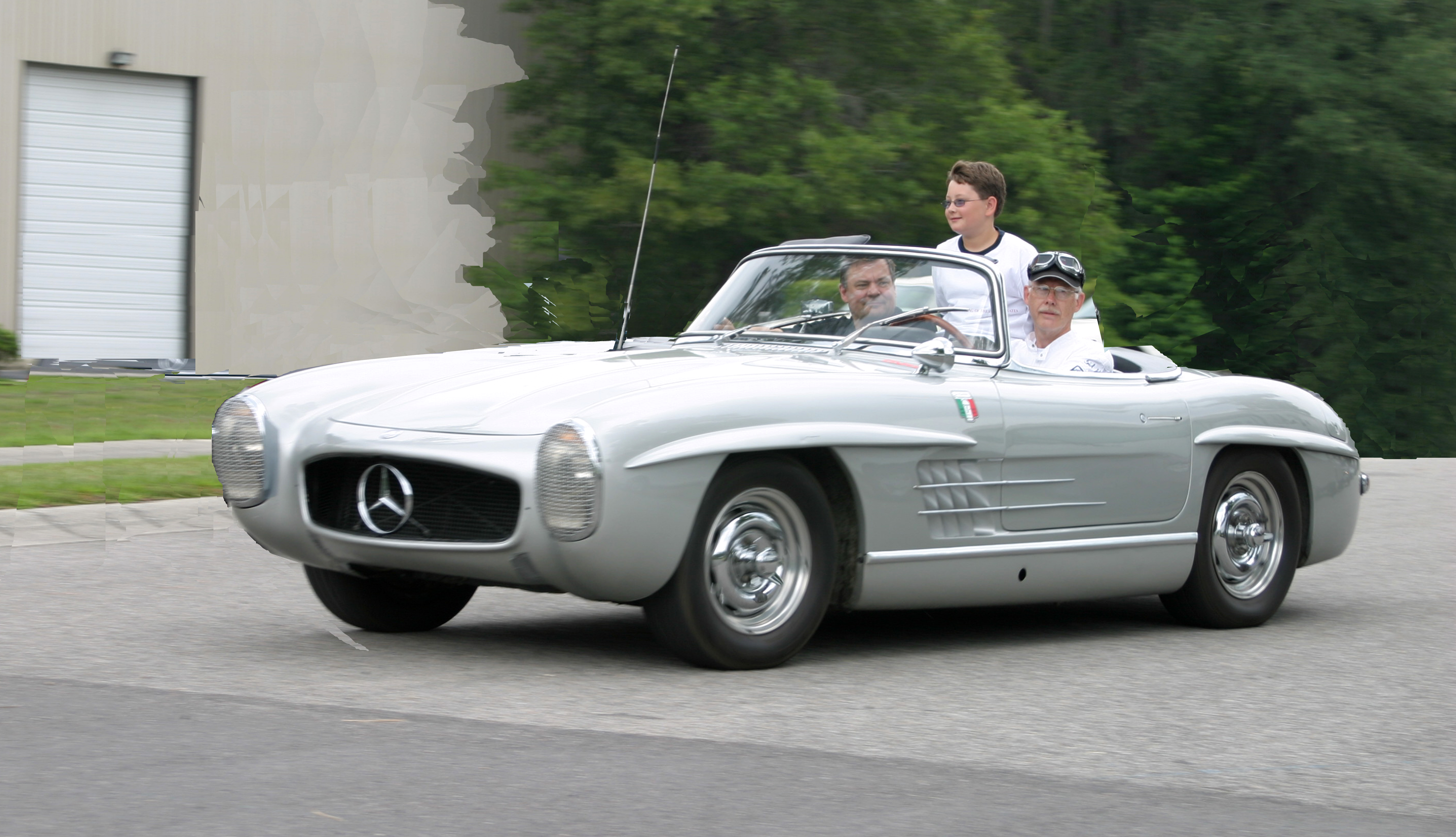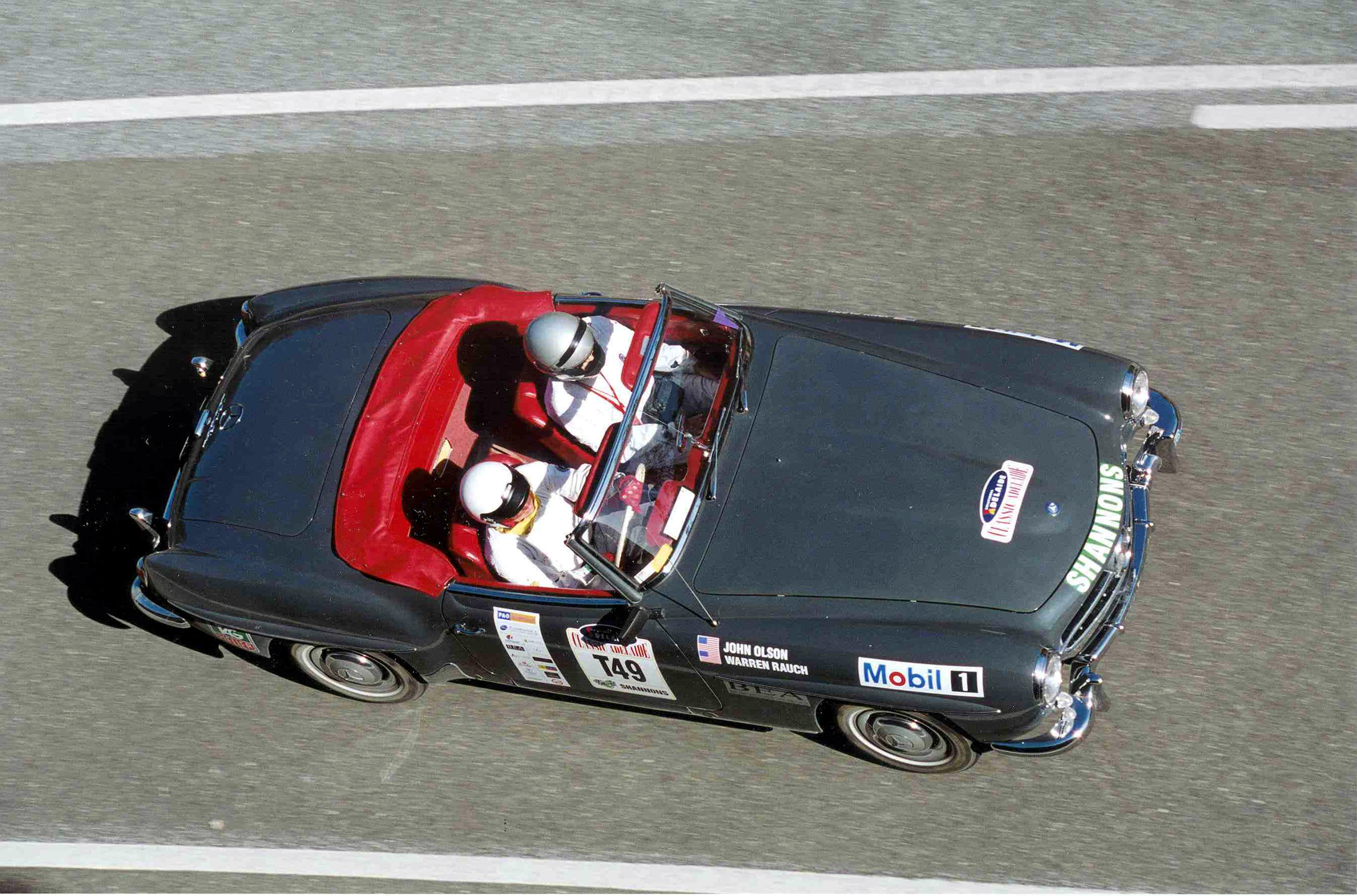 The 1954-1961 Mercedes-Benz 300 SL has no across-the-board equal for a gold standard title.
The 1954-1961 Mercedes-Benz 300 SL has no across-the-board equal for a gold standard title.
An Internet search for the 50 most expensive cars ever sold at auction found only two Mercedes-Benz automobiles. One was a 1936 540S Special Roadster at $37.7 million, and a 1954 W196 open-wheel Gran Prix Racer for $31.7 million. The G.P. Racer was never intended for public sale, but that’s another story. The top 50 sale prices ranged from $10.8 to $49.4 million. With this information noted, how can a mere million-dollar 300SL be the gold standard? The answer is simple: What’s money got to do with it?
I’ve admired, written about, and owned a half dozen notable cars, and served as chief judge for several National Concours d’Elegance. I have distilled five important criteria whereby the 1954-1961 Mercedes-Benz 300 SL has no across-the-board equal for a gold standard title.
Presence of the brand
Mercedes-Benz is both the oldest and most consistently prominent auto brand in the world. Its presence is ubiquitous from royal motor pools and Formula One racing victories to Freightliner trucks and Europe’s favorite tour buses, as well as in our own garages. The three-pointed star is one of the three most recognized non-alphabetic product-symbols in the world. People in every nation recognize the three-pointed star. Unlike Duesenberg, Packard, and other renowned candidates, Mercedes-Benz is still with us! Likewise, the original 300SL, now out of production for six decades, still appears regularly on lists of the world’s most admired cars.
Significance of design
Mercedes-Benz and its suppliers invest more dollars per decade in research and development than any two other car manufacturers, including General Motors. It's no surprise that Mercedes-Benz trucks had ABS brakes as early as 1971. The brand was also first with crash-zone absorbing bodies and anti-slip control brake circuitry in late 1970s.
The 1950s engineering in the 300SL is jaw-dropping even today. From the lightweight birdcage frame, to the fuel-injected engine converting a mere three-liter displacement to 240 horsepower, the 300SL was more powerful than American “big-block” V-8 engines when introduced. The Mercedes also achieved twice the MPG of the Ferraris it beat in 1950s racing.
The 300SL carried a 14-quart dry-sump oil system, 20-quart radiator and 26 & 34-gallon gas tanks in the Roadster and Coupe, respectively. The car even carried dual electric and mechanical fuel pumps. The cars also featured two heaters, three-position seat backs, back-up lights, windshield washers, and Coupe passengers have their very own horn button!
The 300SL suspension uses advanced coil springs all around with a pivoting differential. All has been proven to deliver legendary dependability. The body’s low-air-drag coefficient was pioneered in the first car-sized wind tunnel, which gave impetus for the racing version becoming a coupe.
A half-century later, the 300SL's styling still captures designer praise. Brook Stevens, the late industrial designer, served as Aesthetic Judge at a large Concours d’Elegance to award “The Most Elegant Car on the Judging Field.” Explaining his reasons for selecting a 300SL he said, “Automobile designers shape cars to look either strongly masculine with bold straight lines or feminine with soft flowing lines. The 300SL does the best job of mixing both in the same design.”
Unprecedented owner experience
Can anyone name another famous car with more current-day support from its maker and its owners? Mercedes-Benz maintains two Classic Centers in the USA and Germany dedicated to the preservation of Mercedes-Benz cars over 20 years old. Then add the well-organized owner clubs that function as “support groups” that are nearly fraternal. Finally, there are a dozen of the world’s most respected restorers who are passionate about correct 300SL preservation.
Except for the infamous necessity to learn gracious Gullwing entry and egress, all 300SLs are user-friendly machines. They are easy to drive and known for staying tuned for years. My own 1959 300SL has not required a change of spark plugs for years. My wife and I have averaged about 3,000 miles per year, counting several trips to Canada and Mexico, plus California, New England, and one wonderful month in Europe when our car was accepted in Italy’s Mille Miglia. We owned a trailer initially but sold it 10 years ago because our SL is so much fun to drive.
Five years ago I hoped we could get a new windshield due to small stone chips. The local Mercedes-Benz dealer called back in 48 hours. The windshield had already arrived from the Classic Center! Last year I learned even 300SL body parts are available again from the factory. Of course these cars become keepers, and appreciating retirement assets that we can play with rather than just count!
Future value
When we bought our first 300SL in 1977, I had been following the market for over five years. Each time I looked, prices were higher. When I caught up with a healthy red coupe I paid “all the money” or at least it felt like that. A couple lower-priced sales during the next year made my stomach tighten. Had I bought at the high-water mark? I reminded myself that I’d aspired to own an SL since I was a boy and I was enjoying every minute!
I joined the Gull Wing Group where I met other owners and began entering vintage rallies and tours. I displayed the car when invited. Talk about a magnet: I am still continuously flattered by people thanking me just for seeing it! They tell me I’m living their dream!
Longer into my ownership I realized that following current price fluctuations misses the bigger picture. It is easy to read too much into the latest record sale, high or low, or a no-sale, as I did in our first years after purchase.
Five years into ownership our $32,000 investment had doubled. The SL also opened the door to new friendships all over the world. It's easy now to see how we became long-term owners. Appreciation began seeming logarithmic; it took no more years for $60,000 to become $120,000 than it took from $32,000 to $60,000! Excuse me for saying it, but it has also taken no more years to go from $500,000 to $1 million.
As already mentioned above, appreciation is not unique to the 300SL. Documented sales of true Condition 1 and trophy-winning 190SL and later Pagoda SL models have now both passed $150,000. Ditto for 300SE, 280SE 3.5 convertibles, and 300SEL 6.3 sedans. A following has even developed for the humble, but iconic, 1980s Mercedes-Benz CD Coupes and TDT Wagons, with record sales over $30,000. Bargains do still pop up under half that amount, but the window is closing. Mercedes provides a collector car for every pocketbook!
While publishing the paper-bound SL Market Letters, I wrote about resale trends from each decade’s auction results way back to the 1970s for all collectible Mercedes. We threw out extreme high and low prices each year, what statisticians call “marginal deviates” that tend to distort averages, then compared the numbers year by year. Bottom line: the exercise taught me again to stop focusing on the latest fluctuations; it’s the whole enchilada that matters.
For the 300 SL, annual appreciation of Coupes & Roadsters has averaged 10% to 12% compounded for 50 years! Until the 1980s, Roadsters built from 1957-1963 slipped to 45% of Gullwing coupe values, a tribute to the Gullwing’s appeal as convertibles usually exceed the value of their hardtop siblings. This anomaly has since faded with Roadster values near parity today.
Owner demographics
The importance of organized owners cannot be overstated. Single-model Mercedes-Benz clubs and websites such as MBCA’s model-specific Internet Talk Forms attract the most active, knowledgeable owners and model-specific experts. As might be expected, 300SL owners tend to be successful in their own fields and become formidable spokesmen for their favorite chariots.
Two extreme examples include the largest 300SL owner groups: International Gull Wing Group (GWG) and 300SL Club e V. (Europe). Combined, the members of these clubs own about 50% of the 2,000 coupes and roadsters thought to survive. While the number of survivors is high compared to famous Ferrari and Bugatti models, it has fostered these remarkable clubs. The Gull Wing Group has even launched Zoom sessions to stay in contact this winter.
The 300SL camaraderie makes the next news less surprising. Something the younger 190SL Group and Pagoda Group can anticipate: a survey of the GWG members a few years ago found the average length of ownership to be 23 years for Gullwings, and 22 years for roadsters. It is probably 30 years today. I think that’s the definition of a keeper. Counting our switch from coupe to roadster, my wife and I have logged 43 years of ownership to date.
The consequence of long ownership is twofold: for owners it is the antithesis of car-flipping. Collectible cars are often owned deep into retirement, plus story-book heirloom-legacies that rarely survive the recipient’s less idyllic necessities. Hearing new auction results can be an opportunity for a candid discussion about whether Dad’s hobby has more than dollar appeal. If a sale is inevitable, the long-term owner is far better suited to enhance a sale than an otherwise-focused heir.
Buying and selling
I first became involved in managing a 300SL bid sale when the Ohio State University College of Engineering was given a 300SL Gullwing by a grateful alumnus. The school’s Dean requested that I stage bidding concurrently to the school alumni and car enthusiasts. The Board of Deacons apparently preferred dollars to an exhibit of German engineering excellence in their halls.
Since that first sale, I’ve conducted over a dozen successful 300SL bid sales, usually with the long-term owner meeting with bidders when requested, as would occur in a private sale. The car never leaves the seller’s possession until sold. I personally guarantee that all bids are real.
For prospective owners, there is no abundance of any pre-1972 SL models for sale. Approximately twenty examples of the 300SL are sold worldwide each year. That is barely 1% of total surviving production. We don’t see many 190SL models for sale annually either, considering there were eight built for every 300SL. The Pagoda 230/250/280SL line found 19,280 original USA owners. These cars also seem to be long-term keepers.
On the demand side there is a formidable new player on the scene for all iconic Mercedes-Benz, and it's in Asia. It started with Korean and Japanese enthusiasts. When they brought their cars to the Pebble Beach Concours d’Elegance, they were so impressed they bought Pebble Beach! Today China has more billionaires than Europe, India and Japan combined. That genie won't get back in the bottle! Nor will today’s Mercedes-Benz marketing help: 30 AMG-exclusive Dealers are already ensuring the three-pointed star’s presence and history in today’s China.
In short, the demand for iconic Mercedes of all decades appears alive and well, worldwide. The gold standard experience crosses all borders. Learn more at www.slmarket.com.

